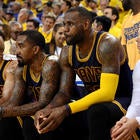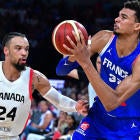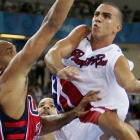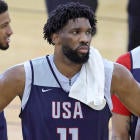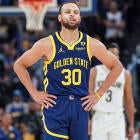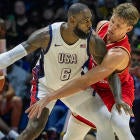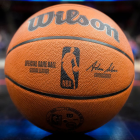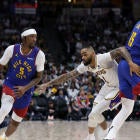The Golden State Warriors took Game 1 of the 2016 NBA Finals 104-89 over the Cleveland Cavaliers. We saw a lot of unusual stuff in that first game from both sides. They missed shots they normally wouldn't miss, stars played poorly when usually they shine, and it was a battle of the reserves that kept the defending champs in the driver's seat with home-court advantage.
What happened in Game 1 and what is likely to carry over into the rest of the series? Let's take a look at some of the key numbers from the first game.
47 percent
The Cavs were an atrocious 18 of 38 (47.3 percent) in the restricted area in a game in which they made just 38.1 percent of their shots overall. On non postup possessions that ended with a shot around the rim, they were even worse at 12 of 32 (37.5 percent), according to Synergy Sports. How could they possibly have been that bad, even against a great defense like the Warriors? Is there any chance of them being that bad around the rim again the rest of the series?
A lot of it starts with LeBron James, who typically is able to attack the rim and convert at a high rate. During the regular season, James converted 69.6 percent of his chances in the restricted area. In the first three rounds of the playoffs, LeBron was making 72.2 percent of his restricted area attempts. He was just 6 of 14 (42.8 percent) in the first game against the Warriors, and a lot of his misses around the basket seemed fluky. There was time after time where he had the ball inside and you expected him to finish. It was almost astonishing that he couldn't.
Some of these are great defensive efforts by the Warriors in their help, but some of them are just LeBron missing what he should be making. Especially the last layup in the video, that's one you expect him to make 11 times out of 10. Maybe the presence of Draymond Green, Andre Iguodala and Andrew Bogut around the basket when he has the ball will affect him.
The first two rounds of the playoffs saw Green allowing just 34 percent when defending the rim. That increased to 42.9 percent, which is a big increase but still a stellar percentage (especially for someone 6-feet-7). Bogut allows 46.6 percent at the rim. These percentages don't completely account for deterring opponents from getting the ball at the basket, but they're a decent enough measure for impact protecting the rim. And of course, Iguodala has to make any player nervous that he'll just rip the ball from them.
A big part of this is also not letting Tristan Thompson get going around the hoop, especially on offensive rebounds. He grabbed six offensive boards in Game 1, and the Cavs scored eight points on those extra chances. Four of those points came from someone else rebounding a miss by Thompson after he grabbed an offensive rebound. Whenever he was going for the tip, the Warriors swarmed the paint.
There was even a cut off a postup by James, who kicked it out to Kevin Love before he whipped a pass to a cutting Thompson that was met at the rim by Klay Thompson to force the miss. Tristan had moments in this game where he made a difference on the boards, but the Warriors were hyper aware of trying to limit his put-back chances.
And there were just some bad, open misses by the Cavs in this game that didn't make any sense. Kevin Love had a move into the paint where he badly missed a layup that should've dropped. Kyrie Irving had an open layup on that same side of the hoop as Love, which randomly caromed off the side of the rim.
You can look at it one of two ways: 1) the Warriors allowed an uncharacteristically high number of shots inside that weren't highly contested and they can correct that or 2) the Cavs missed a ton of easy looks inside and probably won't do that again. Or maybe it's both. Either way, they have to be better converting at the rim from here on out.
70.8
One thing the Cavs tried to do in this game was exploit mismatches off of switching. The Warriors switch a ton -- almost always switching a pick situation while trusting the help will be there -- and the Cavs were aware of trying to exploit these individual matchups that arose from that switching. Sometimes this resulted in isolation plays, but more often than not it ended up as a postup opportunity. Here's the problem with that and it ties in a little bit with the poor finishing around the rim.
The Cavs were awful at scoring in the post in this game. There were 24 possessions in which the Cavs used a postup that resulted in a shot or turnover by either man posting up or the player receiving the pass out of a postup. The Cavs scored 17 points on those 24 possessions. That's good for 70.8 points per 100 possessions. To put that in perspective, the Philadelphia 76ers had the worst offense in the NBA this season with an offensive rating of 96.6. So the Cavs' offense posting up against the Warriors in Game 1 is roughly 26 points per 100 possessions worse than the Sixers' offense.
That's pretty awful. Eight of those 17 points came in the first quarter too, meaning quarters 2-4 yielded 50 points per 100 possessions on postups. Here's how the Warriors defended it and how effective it was when they did:
- Single coverage in the post saw Cavs score eight points on seven possessions (114.2 off. rating)
- Hard double/defense collapsing in the post saw Cavs score nine points on 17 possessions (52.9 off. rating)
When the Warriors allowed the Cavs to go single coverage, it was a great idea for Tyronn Lue's team. When the Warriors swarmed those postups, it was the scoring efficiency of an average JV high school team. Conversely, the Warriors only had three possessions in this game that were classified as postup possessions. I think the Warriors want the Cavs attacking the switches this way.
18
Before we get into the significance of the number 18 in this game, I would like you to watch the following clip. It's of Kyrie Irving going against Steph Curry. Notice him size Curry up on a clear-out, use a great hesitation dribble to freeze Steph, and then hit a nice baseline jumper against the unanimous MVP.
Pretty solid move and play, right? It wasn't one of those ankle-breaker moments we love to Vine, but it's a good one-on-one moment for Irving in this game. It was also only one of two made baskets the Cavs got all night in isolation plays. They ran 18 possessions that resulted in an iso set leading to a shot, trip to the free throw line or turnover. Irving got that basket there. LeBron had a layup against Festus Ezeli. And that's all they were able to do.
Kyrie did have two other isolation possessions that got him a trip to the free throw line. He hit three of the four free throws. If you're scoring at home, that's seven points on 18 isolation possessions. That's an offensive rating (38.8) that mirrors an Andre Drummond season at the free throw line. Although I'm not sure anybody will suggest the Cavs shoot underhand on their isolation attempts.
20
The job the Cavs did on Stephen Curry and Klay Thompson was superb. The Splash Brothers shot a combined 8 of 27 from the field and 4 of 13 from deep. It was their lowest combined point total in a game (with significant minutes) since Feb. 26, 2014, when the Warriors got stomped by the Chicago Bulls 103-83. Curry had five points in 28 minutes that night, while Klay eight points in 23 minutes.
Cleveland stuck to Curry by forcing 10 of his 15 shots to be contested. He was just 3 of 10 on those contested shots and 1 of 5 on uncontested shots. Some of those jumpers were rushed, but the Cavs also benefited from Curry just missing a few open ones too -- much like the Warriors benefited from those weird missed layups by the Cavs. Thompson was 3 of 6 on contested shots and 1 of 6 on uncontested shots. He was taken out of rhythm by the Cavs' perimeter defense and chased pretty well by J.R. Smith a lot of the night.
93
NBA.com/stats had Game 1 clocked in at about 93 possessions. That's a very slow pace for both teams, and the ugliness of the game reflected that pace quite often. There wasn't a ton of flow to what was going on. The game plan going in was for the Cavs to push the pace. They wanted to set the tempo high because when they're pushing the ball up the floor, it allows them to force the defense into quick matchups that Cleveland can then exploit. None of that really happened in Game 1.
Part of that is the Warriors' shooting. They didn't shoot well from 3-point range, but they did make 49.4 percent of their shots. Making nearly half your shots doesn't allow for the other team to get out and run on misses. Cleveland had 14 transition possessions, according to Synergy Sports, and scored 18 points off those possessions. That's 128 points per 100 transition possessions. That's a very high level of scoring efficiency, so it makes sense that they want to run off misses and turnovers.
"Pace, so we can get up the floor and get guys open shots in transition like J.R. and Kevin and Channing and those guys," Tyronn Lue said after practice on Friday. "But I think the floor's more open when you're able to play with pace and LeBron and Kyrie can get downhill. Ball movement, we're running our sets. When you're switching 1 through 5, it makes you stagnant. It makes you play one-on-one.So the best thing you can do is try to get the match-up you want and try to explore it."
The Warriors had 20 transition possessions, which yielded 20 points. That's not very good for transition efficiency, but I'm not sure you want to tempt the pace gods with allowing the Warriors to get into a rhythm by moving the ball up the floor. The Cavs will need to find that balance. They can preach pace all they want, but it won't matter if they can't get stops in the first place. And you want to control when the running happens because a track meet with the Warriors is like trying to take down Usain Bolt.
17-9
The Cavaliers turned the ball over 17 times compared to just nine times for the Warriors. Golden State made them pay almost every time. It turned those 17 turnovers into 25 points, compared to just 12 points off nine turnovers by the Warriors. That's too big of a margin to overcome in a game like this. The Cavs have to take care of the ball better and they have to be more productive in forcing the Warriors into mistakes with the basketball.
When the Cavs turn the ball over 17 times or more this season, they're 10-7, including the playoffs. That's not a bad record but it's well below the 57-win record they ended up with this season. For the Warriors, they've had just 11 games in which they managed single-digit turnovers. You can probably guess they're 11-0 in those games.
33.3 percent
The Cavs and the Warriors are the two greatest 3-point shooting teams in postseason history. They'll both likely break the Warriors' record of 240 makes last postseason. That is unless they continue to shoot horrendously from 3-point range like they did in Game 1. Both teams made just one-third of their attempts with the Cavs shooting 7 of 21 from deep and the Warriors going 9 of 27 from downtown.
It was the 33rd time the Cavs have shot this poorly from 3-point range. They're 18-15 in those games, making it a little better than a coin flip. That's a far cry from the 43.4 percent they shot against the Eastern Conference in the playoffs. A lot of their missed 3-pointers came on "open looks" (4-6 feet between them and the defender). They were 0 of 2 on tight (2-4 feet) coverage, 2 of 9 on open 3-pointers and 5 of 10 on wide-open (more than six feet of room) looks.
The Warriors know they have to keep the Cavs out of rhythm from the perimeter in order to keep up this defensive success.
"They're obviously a team that shoots the three very well and can get hot at any time," Curry said after practice between Games 1 and 2. "But the key is trying not to let them get open looks and find a rhythm.So from the jump, you want to be able to try to impact their offensive rhythm by not having a miscommunication, having great rotations on the perimeter and contesting shots."
For the Warriors, it was just their 16th game in which they made only one-third of their 3s or worse. They're 10-6 in those games. They had a very similar shooting profile to the Cavs. They were 1 of 4 on tight looks, 3 of 12 on open looks and 5 of 11 on wide-open 3-pointers. Neither team is likely to shoot this poorly again.
1-6
LeBron James is now 1-6 in Game 1s in the NBA Finals. The good news for the Cavs and their fans is that of the two championships he won in Miami, he lost Game 1 to both Oklahoma City and San Antonio.
12
More good news for the Cleveland Cavaliers: LeBron has won 12 straight Game 2s in any playoff series. His teams are 5-2 in NBA Finals Game 2s.
79
Bad news for Cleveland: Warriors won Game 1 and that means they have a 79 percent chance of winning this series.
Teams with homecourt who win Game 1 have won the series 79% of the time.
-- Hardwood Paroxysm (@HPbasketball) June 3, 2016
I guess we'll find out soon enough.










